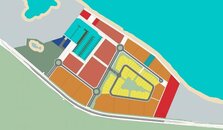El Graduado
Contributor
- Messages
- 833
- Reaction score
- 1,666
Fondo Nacional de Fomento al Turismo (FONATUR) is the entity responsible for the construction of the new FONATUR Marina adjacent to Caleta in Cozumel. FONATUR’s first project was in 1974, when they designed and built the tourist complex of Cancun.
The organization has nine other marinas under their belt (all in the western coast of Mexico), but this one in Cozumel proved to be a tough one to finish. It has been a case study of a project rife with unforeseen obstacles, cost overruns, and delays. Since 37.4 million dollar project was started in 2008, under Felipe Calderon’s presidency, it was imperative (as is customary in Mexico) to have a ribbon cutting of the project before he left office. That inauguration ceremony took place on March 20, 2012, even though the project was well short of completion.
Part of the delay was due to the unbelievable fact that the land was purchased and the excavation of the artificial bay was begun prior to FONATUR actually acquiring the strip of land that separated the marina from the sea. This strip of land belonged to Hotel Presidente. The owners of the hotel were well aware of the great hand that they held and bided their time as the construction began. The negotiations for the strip of land that blocked the exit to the sea took a longer-than-budgeted amount of time, simply because Hotel Presidente held out for the best possible offer, which they eventually got.
Below is a copy of what FONATUR called the project’s “Master Plan,” back when work started. Note the entrance to the marina was yet to be resolved:
The plan called for 4,523 lots, consisting of four hotels (the dark-rust areas), beach club (white area) commercial establishments (reddish areas, condos (brown areas), a “thematic park” (green area), single-family residences (yellow areas), and of course, the marina, including restaurants, gas station, yacht club and dry dock.
The next delay in construction was caused by the fact that the environmental impact study that FONATUR commissioned was contested by local environmentalists, who pointed out that once the barrier between the newly excavated marina and the sea was breached, the sascap dust (unconsolidated aragonite) would be carried out over the reef and settle over the coral, smothering it. This argument was disputed by the company that FONATUR had hired to do the impact study, but FONATUR eventually agreed to settle the matter by placing a temporary barrier at the mouth of the marina that would help keep the sediment in place and not be washed out at once over the reef once the entrance was opened.
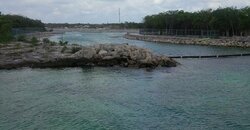
The next faux-pas was due to a lack of a proper geological investigation of the area surrounding the entrance. If the geological investigation had been done properly, it would have shown that Caleta was not a natural bay, but had been formed when the roof of a natural cave/tunnel carrying freshwater collapsed. This type of structure is common in the karst coastline of Quintana Roo; Xel Ha and Xcaret are just two examples of the mature form of this structure. Chankanaab is an example of an immature form, or one that hasn’t fully opened to the sea yet. The reason that prior knowledge of this undersea outlet would have been important to the design of the marina is that it is prohibited to disrupt these coastal freshwater outlets; they are protected by law. When the contractor began to excavate the entrance to the prescribed depth, they were stopped and not allowed to dig any deeper. The planned twelve-foot depth at the entrance was now limited to a shallow nine feet. That meant that many fixed-keel sailboats (and deep draft working boats) could not ever enter the marina. The original plan was that the new marina be a magnet that would attract both large and small vessels, but now it is limited to only shallow-draft boats.
Amazingly, this same problem with freshwater cenotes was encountered earlier by the contractor who built Avenida Miguel Aleman (the road that goes from Avenida 30 to the car ferry pier), but it seems like nobody remembered. The contractor for that project also failed to take into account the cenote near the edge of the Carretera Sur and when they began filling it in with rubble so they could build the road over it they were stopped because of the environmental law prohibiting the filling of a freshwater cenote. The contractor eventually had to build a bridge over the opening and put a slight dog-leg in the road to be able to complete the project, over budget and overtime.
The requirement of a re-routed “dog-leg” also came up at the FONATUR Marina. Originally the entrance was planned to be a wide opening. See the original mock-up below:
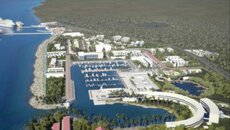
However, the actual entrance ended up being very narrow and it also requires boats to make a hairpin turn in order to enter. See the satellite photo below. (note: the old road to the beach is still shown as a line crossing the entrance in the map overlay) The entrance had to be relocated because 90 square meters of mangroves were located exactly where they had planned to dig the entrance and mangroves are protected under the Ley de Vida Silvestre.
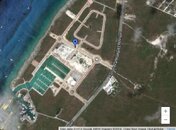
As an aside, while I was looking at the FONATUR website, I noticed that they couldn’t even place north correctly on the map!

If you believed the mocked-up image they produced of the proposed 3.6 hectare marina (below) the 333 berths would be huge and there would be plenty of maneuvering room at the wide, straight entrance, as well as in the lanes inside the marina.
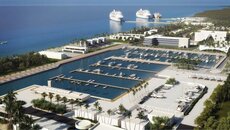
However, when the docks were finished, there turned out to be barely enough room for a dive boat to squeeze into a berth. If there is another boat tied up in the berth opposite, it would be very difficult, according to a captain who had temporarily berthed a couple of his boats there during the fishing tournament last year in order to free up spaces for visitors in Caleta. The visitors who came for the tournament couldn’t use the new marina because it didn’t have electricity, water, sewer, cleats, or “dead men” (permanently-emplaced bow anchors) among many other things. It still doesn’t. Apparently, the project went over budget and new funding hasn’t been released yet with which to finish the work. FONATUR has been scrambling to meet its debt obligations since 2012, but on October 30 of this year, they announced they had reached an agreement with Banobras regarding a restructuring of its debt and Hacienda seems ready to release the 90 million pesos needed to complete the project, so maybe the end is in sight.
www.everythingcozumel.com Books, maps, and articles about Cozumel
The organization has nine other marinas under their belt (all in the western coast of Mexico), but this one in Cozumel proved to be a tough one to finish. It has been a case study of a project rife with unforeseen obstacles, cost overruns, and delays. Since 37.4 million dollar project was started in 2008, under Felipe Calderon’s presidency, it was imperative (as is customary in Mexico) to have a ribbon cutting of the project before he left office. That inauguration ceremony took place on March 20, 2012, even though the project was well short of completion.
Part of the delay was due to the unbelievable fact that the land was purchased and the excavation of the artificial bay was begun prior to FONATUR actually acquiring the strip of land that separated the marina from the sea. This strip of land belonged to Hotel Presidente. The owners of the hotel were well aware of the great hand that they held and bided their time as the construction began. The negotiations for the strip of land that blocked the exit to the sea took a longer-than-budgeted amount of time, simply because Hotel Presidente held out for the best possible offer, which they eventually got.
Below is a copy of what FONATUR called the project’s “Master Plan,” back when work started. Note the entrance to the marina was yet to be resolved:
The plan called for 4,523 lots, consisting of four hotels (the dark-rust areas), beach club (white area) commercial establishments (reddish areas, condos (brown areas), a “thematic park” (green area), single-family residences (yellow areas), and of course, the marina, including restaurants, gas station, yacht club and dry dock.
The next delay in construction was caused by the fact that the environmental impact study that FONATUR commissioned was contested by local environmentalists, who pointed out that once the barrier between the newly excavated marina and the sea was breached, the sascap dust (unconsolidated aragonite) would be carried out over the reef and settle over the coral, smothering it. This argument was disputed by the company that FONATUR had hired to do the impact study, but FONATUR eventually agreed to settle the matter by placing a temporary barrier at the mouth of the marina that would help keep the sediment in place and not be washed out at once over the reef once the entrance was opened.

The next faux-pas was due to a lack of a proper geological investigation of the area surrounding the entrance. If the geological investigation had been done properly, it would have shown that Caleta was not a natural bay, but had been formed when the roof of a natural cave/tunnel carrying freshwater collapsed. This type of structure is common in the karst coastline of Quintana Roo; Xel Ha and Xcaret are just two examples of the mature form of this structure. Chankanaab is an example of an immature form, or one that hasn’t fully opened to the sea yet. The reason that prior knowledge of this undersea outlet would have been important to the design of the marina is that it is prohibited to disrupt these coastal freshwater outlets; they are protected by law. When the contractor began to excavate the entrance to the prescribed depth, they were stopped and not allowed to dig any deeper. The planned twelve-foot depth at the entrance was now limited to a shallow nine feet. That meant that many fixed-keel sailboats (and deep draft working boats) could not ever enter the marina. The original plan was that the new marina be a magnet that would attract both large and small vessels, but now it is limited to only shallow-draft boats.
Amazingly, this same problem with freshwater cenotes was encountered earlier by the contractor who built Avenida Miguel Aleman (the road that goes from Avenida 30 to the car ferry pier), but it seems like nobody remembered. The contractor for that project also failed to take into account the cenote near the edge of the Carretera Sur and when they began filling it in with rubble so they could build the road over it they were stopped because of the environmental law prohibiting the filling of a freshwater cenote. The contractor eventually had to build a bridge over the opening and put a slight dog-leg in the road to be able to complete the project, over budget and overtime.
The requirement of a re-routed “dog-leg” also came up at the FONATUR Marina. Originally the entrance was planned to be a wide opening. See the original mock-up below:

However, the actual entrance ended up being very narrow and it also requires boats to make a hairpin turn in order to enter. See the satellite photo below. (note: the old road to the beach is still shown as a line crossing the entrance in the map overlay) The entrance had to be relocated because 90 square meters of mangroves were located exactly where they had planned to dig the entrance and mangroves are protected under the Ley de Vida Silvestre.

As an aside, while I was looking at the FONATUR website, I noticed that they couldn’t even place north correctly on the map!

If you believed the mocked-up image they produced of the proposed 3.6 hectare marina (below) the 333 berths would be huge and there would be plenty of maneuvering room at the wide, straight entrance, as well as in the lanes inside the marina.

However, when the docks were finished, there turned out to be barely enough room for a dive boat to squeeze into a berth. If there is another boat tied up in the berth opposite, it would be very difficult, according to a captain who had temporarily berthed a couple of his boats there during the fishing tournament last year in order to free up spaces for visitors in Caleta. The visitors who came for the tournament couldn’t use the new marina because it didn’t have electricity, water, sewer, cleats, or “dead men” (permanently-emplaced bow anchors) among many other things. It still doesn’t. Apparently, the project went over budget and new funding hasn’t been released yet with which to finish the work. FONATUR has been scrambling to meet its debt obligations since 2012, but on October 30 of this year, they announced they had reached an agreement with Banobras regarding a restructuring of its debt and Hacienda seems ready to release the 90 million pesos needed to complete the project, so maybe the end is in sight.
www.everythingcozumel.com Books, maps, and articles about Cozumel



